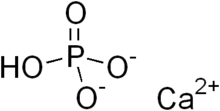Dicalcium phosphate
 | |
| Names | |
|---|---|
| IUPAC name
Calcium hydrogen phosphate dihydrate | |
| Other names
Calcium Hydrogen Phosphate Phosphoric acid, calcium salt (1:1) | |
| Identifiers | |
| 7757-93-9 7789-77-7 (dihydrate) | |
| 3D model (Jmol) | Interactive image |
| ChemSpider | 94606 |
| ECHA InfoCard | 100.028.933 |
| PubChem | 104805 |
| UNII | L11K75P92J |
| |
| |
| Properties | |
| CaHPO4 | |
| Molar mass | 136.06 g/mol (anhydrous) 172.09 (dihydrate) |
| Appearance | white powder |
| Odor | odorless |
| Density | 2.929 g/cm3 (anhydrous) 2.31 g/cm3 (dihydrate) |
| Melting point | decomposes |
| 0.02 g/100 mL (anhydrous) 0.02 g/100 mL (dihydrate) | |
| Structure | |
| triclinic | |
| Hazards | |
| NFPA 704 | |
| Flash point | Non-flammable |
| Related compounds | |
| Other anions |
Calcium pyrophosphate |
| Other cations |
Magnesium phosphate Monocalcium phosphate Tricalcium phosphate Strontium phosphate |
| Except where otherwise noted, data are given for materials in their standard state (at 25 °C [77 °F], 100 kPa). | |
| | |
| Infobox references | |
Dicalcium phosphate is the calcium phosphate with the formula CaHPO4. The "di" prefix in the common name arises because the formation of the HPO42– anion involves the removal of two protons from phosphoric acid, H3PO4. It is also known as dibasic calcium phosphate or calcium monohydrogen phosphate. There are three crystalline forms: a dihydrate, CaHPO4•2H2O ('DPCD'), the mineral brushite; a hemihydrate, CaHPO4•0.5H2O; and anhydrous CaHPO4, ('DCPA'), the mineral monetite. Below pH 4.8 the dihydrate and anhydrous forms of dicalcium phosphate are the most stable (insoluble) of the calcium phosphates. Dicalcium phosphate is used as a food additive, it is found in some toothpastes as a polishing agent and is a biomaterial.[1][2] In the dihydrate (brushite) form it is found in some kidney stones and in dental calculi.[3][4]
Preparation
Dibasic calcium phosphate is produced by the reaction of calcium chloride and phosphoric acid:
- CaCl2 + H3PO4 + 2 NaOH → CaHPO4 + 2 NaCl + 2 H2O
Calcium hydroxide is also used in place of the calcium chloride and sodium hydroxide. The room temperature neutralisation of phosphoric acid with calcium hydroxide at pH 3-4 precipitates the dihydrate. At 60°C the anhydrous form is precipitated:[4]
- H3PO4 + Ca(OH)2 → CaHPO4
One industrial preparation of the dihydrate involves the reaction of H3PO4 with a slurry of Ca(OH)2 below 40°C. To prevent degradation that would form hydroxyapatite, Sodium pyrophosphate or trimagnesium phosphate octahydrate are added when for example, dibasic calcium phosphate dihydrate is to be used as a polishing agent in toothpaste.[1]
Anhydrous CaHPO4 is an intermediate in the production of halophosphate phosphors that were used in fluorescent lamps. In a continuous process CaCl2 was reacted with (NH4)2HPO4 to form the dihydrate, CaHPO4•2H2O.
- CaCl2 + (NH4)2HPO4 → CaHPO4•2H2O
A slurry of the dihydrate is then heated to around 65–70°C to form anhydrous CaHPO4 as a crystalline precipitate in the desired form, (typically a flat diamond shaped crystal, 7-9 μm), which was suitable for further processing.[5]
Dibasic calcium phosphate dihydrate is formed in "brushite" calcium phosphate cements (CPC's) which have medical applications. An example of the overall setting reaction in the formation of "β-TCP/MCPM" (β-tricalcium phosphate/monocalcium phosphate) calcium phosphate cements is:[6]
- Ca3(PO4)2 + Ca(H2PO4)2•H2O + 7 H2O → 4 CaHPO4•2H2O
Uses
Dibasic calcium phosphate is mainly used as a dietary supplement in prepared breakfast cereals, dog treats, enriched flour, and noodle products. It is also used as a tableting agent in some pharmaceutical preparations, including some products meant to eliminate body odor. Dibasic calcium phosphate is also found in some dietary calcium supplements (e.g. Bonexcin). It is used in poultry feed. It is also used in some toothpastes as a tartar control agent.[7]
References
- 1 2 Corbridge, D. (1995). "Chapter 3: Phosphates". Studies in inorganic Chemistry vol. 20. Elsevier Science B.V. pp. 169–305. ISBN 0-444-89307-5. Retrieved January 30, 2015. – via ScienceDirect (Subscription may be required or content may be available in libraries.)
- ↑ Salinas, Antonio J.; Vallet-Regi, Maria (2013). "Bioactive ceramics: from bone grafts to tissue engineering". RSC Advances. Royal Society of Chemistry. 3 (28): 11116–11131. doi:10.1039/C3RA00166K. Retrieved 15 February 2015. (subscription required (help)).
- ↑ Pak, Charles Y.C, Poindexter, John R, Adams-Huet, Beverley, Pearle, Margaret S (July 2003). "Predictive value of kidney stone composition in the detection of metabolic abnormalities". The American Journal of Medicine. 115 (1): 26– 2. doi:10.1016/S0002-9343(03)00201-8. ISSN 0002-9343. – via ScienceDirect (Subscription may be required or content may be available in libraries.)
- 1 2 Rey, C.; Combes, C.; Drouet, C.; Grossin, D. (2011). "1.111 - Bioactive Ceramics: Physical Chemistry". In Ducheyne, Paul. Comprehensive Biomaterials. 1. Elsevier. pp. 187–281. doi:10.1016/B978-0-08-055294-1.00178-1. ISBN 978-0-08-055294-1. – via ScienceDirect (Subscription may be required or content may be available in libraries.)
- ↑ Ropp, R.C. (2013). "Chapter 4 - Group 15 (N, P, As, Sb and Bi) Alkaline Earth Compounds". Encyclopedia of the Alkaline Earth Compounds. 1. Elsevier. doi:10.1016/B978-0-444-59550-8.00004-1. ISBN 978-0-444-59550-8. – via ScienceDirect (Subscription may be required or content may be available in libraries.)
- ↑ Tamimi, Faleh; Sheikh, Zeeshan; Barralet, Jake (February 2012). "Dicalcium phosphate cements: Brushite and monetite". Acta Biomaterialia. 8 (2): 474–484. doi:10.1016/j.actbio.2011.08.005. ISSN 1742-7061. – via ScienceDirect (Subscription may be required or content may be available in libraries.)
- ↑ Klaus Schrödter, Gerhard Bettermann, Thomas Staffel, Friedrich Wahl, Thomas Klein, Thomas Hofmann "Phosphoric Acid and Phosphates" in Ullmann’s Encyclopedia of Industrial Chemistry 2008, Wiley-VCH, Weinheim. doi:10.1002/14356007.a19_465.pub3
